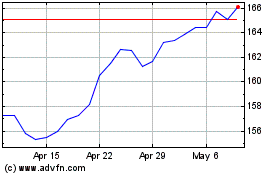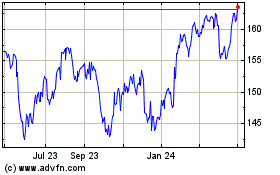Disruptive Food Brands Get a Taste of Their Own Medicine -- Heard on the Street
May 11 2020 - 6:51AM
Dow Jones News
By Carol Ryan
Seeking comfort while sheltering at home, shoppers are reaching
for Hershey Bars rather than gluten-free energy balls. That is bad
news for challenger brands, whose healthy snacks were taking market
share from global food companies until very recently.
Discussing their latest quarterly results, executives at Nestlé,
Kraft Heinz and Procter & Gamble all said consumers are
returning to old-fashioned brands that had previously fallen out of
favor. The Hershey Company noted that its confectionery products
gained 3 percentage points of market share over the past month or
so. As consumers hoard nonperishable food, goods such as processed
cheese and canned soup that had been losing out to healthier
alternatives are recording their strongest sales in years.
It isn't yet clear if the trend will stick, but the shift is
significant. Challenger brands have been taking market share from
global food manufacturers for several years. In January and
February this year, insurgent brands -- defined as those that are
growing more than 10 times faster than their category -- captured
35% of the year-over-year growth in the consumer industry,
according to consulting firm Bain & Company. In March and
April, their share of growth shrank to 5%.
Lack of scale is now a disadvantage. Supermarkets have reduced
the range of products they offer to ensure everyday essentials are
available. That plays to the strengths of global manufacturers like
Nestlé and P&G who can deliver orders in bulk. In the short
term at least, small brands are being elbowed off the shelves.
The asset-light business model favored by insurgent brands also
has downsides. As they use third-party manufacturers rather than
owning factories, these companies struggle to increase capacity
when there is a big spike in demand. They are also competing with
deep-pocketed rivals for constrained logistics services.
Third-party transport costs have increased by 20% in certain
markets.
Even if the distribution squeeze is temporary, startups may not
have the cash to survive for long. Funding for these kinds of
businesses is drying up. Worldwide, the number of venture capital
investments in consumer brands fell 26% in the first quarter of
2020 compared with the same period of last year, PitchBook data
shows. Even before the crisis, investors had moved on to other hot
sectors such as health care and software. Last year, venture
capitalists handed over 54% less cash to consumer brands than in
2018, according to data tracked by Goldman Sachs.
Of course, entrepreneurs are nothing if not nimble and can focus
on selling their goods online. The problem for food brands in
particular is that over 90% of sales still happen in
bricks-and-mortar stores in most markets. Challengers with a
well-established online sales channel may fare better in the
current reversal.
Meanwhile, big food brands have an unlikely opportunity to
regain some of the ground they lost in recent years. They might
even buy up struggling rivals on the cheap.
Write to Carol Ryan at carol.ryan@wsj.com
(END) Dow Jones Newswires
May 11, 2020 06:36 ET (10:36 GMT)
Copyright (c) 2020 Dow Jones & Company, Inc.
Procter and Gamble (NYSE:PG)
Historical Stock Chart
From Mar 2024 to Apr 2024

Procter and Gamble (NYSE:PG)
Historical Stock Chart
From Apr 2023 to Apr 2024
